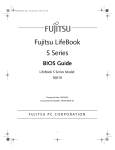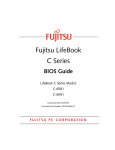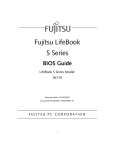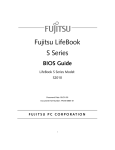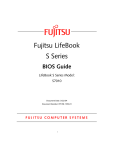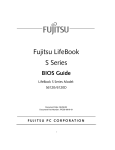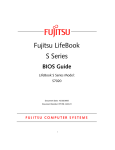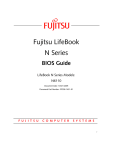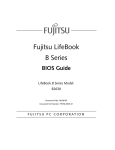Download Fujitsu S-5582 User's Manual
Transcript
Fennel BIOS.fm Page 1 Monday, November 12, 2001 10:52 AM Fujitsu LifeBook S Series BIOS Guide LifeBook S Series Model: S-5582 Document Date: 10/25/01 Document Part Number: FPC58-0624-01 F U J I T S U P C C O R P O R AT I O N 1 Fennel BIOS.fm Page 2 Monday, November 12, 2001 10:52 AM LifeBook S Series BIOS S Series BIOS 4. To activate a submenu press the [Enter] key. 5. To return to a menu from a submenu, press the [Esc] key. 6. To go to the Exit menu from any other menu, press the [Esc] key. BIOS SETUP UTILITY The BIOS Setup Utility is a program that sets up the operating environment for your notebook. Your BIOS is set at the factory for normal operating conditions, therefore there is no need to set or change the BIOS environment to operate your notebook. P O I N TS ■ Selecting a field causes a help message about that field to be displayed on the right-hand side of the screen. ■ Pressing the Enter key with the highlight on a selection that is not a submenu or auto selection will cause a list of all options for that item to be displayed. Pressing the Enter key again will select the highlighted choice. The BIOS Setup Utility configures: ■ ■ Device control feature parameters, such as changing I/O addresses and boot devices. System Data Security feature parameters, such as passwords. Entering the BIOS Setup Utility To enter the BIOS Setup Utility do the following: 7. Pressing the [F9] key resets all items in the BIOS to the default values. 8. Pressing the [F10] key saves the current configuration and exits the BIOS Setup Utility. You will be asked to verify this selection before it is executed. 9. Pressing the [F1] key gives you a general help screen. 1. Turn on or restart your notebook. 2. Press the [F2] key once the Fujitsu logo appears on the screen. This will open the main menu of the BIOS Setup Utility with the current settings displayed. 3. Press the [RIGHT ARROW] or [LEFT ARROW] key to scroll through the other setup menus to review or alter the current settings. Entering the Setup Utility After a Configuration Change or System Failure Navigating Through the Setup Utility If there has been a change in the system configuration that does not agree with the parameter settings stored in your BIOS memory, or there is a failure in the system, the system beeps and/or displays an error message after the Power On Self Test (POST). If the failure is not too severe, it will give you the opportunity to modify the settings of the setup utility, as described in the following steps: The BIOS setup utility consists of seven menus: Main, Advanced, Security, Power, Boot, Info and Exit. This document explains each menu in turn including all submenus and setup items. The following procedures allow you to navigate the setup utility menus: 1. When you turn on or restart the computer there is a beep and/or the following message appears on the screen: Error message - please run SETUP program Press <F1> key to continue, <F2> to run SETUP ], [ ] 1. To select a menu, use the cursor keys: 2. To select a field within a menu or a submenu, use the cursor keys: [ ], [ ]. 3. To select the different values for each field, press the [Spacebar] to change to the next higher selection and [F5] or [-] to go to the next lower selection. 2 Fennel BIOS.fm Page 3 Monday, November 12, 2001 10:52 AM Main Menu 2. If an error message is displayed on the screen, and you want to continue with the boot process and start the operating system anyway, press the [F1] key. POINTS ■ If your notebook beeps a series of beeps that sounds like a code and the display is blank, please refer to the Troubleshooting Section. The Troubleshooting Section includes a list of error messages and their meanings. ■ If your data security settings require it, you may be asked for a password before the operating system will be opened. 3. If an error message is displayed on the screen, and you want to enter the setup utility, press the [F2] key. 4. When the setup utility starts with a fault present, the system displays the following message: Warning! Error message [Continue] 5. Press any key to enter the setup utility. The system will then display the Main Menu with current parameters values. 3 Fennel BIOS.fm Page 4 Monday, November 12, 2001 10:52 AM LifeBook S Series BIOS MAIN MENU – SETTING STANDARD SYSTEM PARAMETERS The Main Menu allows you to set or view the current system parameters. Follow the instructions for Navigating Through The Setup Utility to make any changes. (See Navigating Through the Setup Utility on page 2 for more information) the field’s function and any special information needed to help understand the field’s use. Note that the actual drive labels shown may vary. POINT The following tables show the names of the menu fields for the Main menu and its submenus, all of the options for each field, the default settings and a description of Main Advanced System Time and System Date can also be set from your operating system without using the setup utility. Use the calendar and time icon on your Windows Control panel or type time or date from the MS-DOS prompt. PhoenixBIOS Setup Utility Security Power Boot Info Exit Item Specific Help ▲ ▲ System Time: System Date: [02:34:56] [11/18/1999] Floppy Disk A: [1.44/1.2 MB, 3.5"] Primary Master Primary Slave [HITACHI_DK23DA-20-(PM)] [HITACHI DVD-ROM GD-S250-(PS)] Language: [English (US)] Select Item Select Menu <Tab>, <Shift-Tab>, or <Enter> selects field. -/Space Change Values Enter Select Sub-Menu ▲ F1 Help ESC Exit Adjust calendar clock. Figure 1. F9 Setup Defaults F10 Save and Exit Main Menu Table 1: Fields, Options and Defaults for the Main Menu Menu Field Options Default Description System Time: –— –— Sets and displays the current time. Time is in a 24 hour format of hours:minutes:seconds with 2 digits for each. (HH:MM:SS). Example: 16:45:57. You may change each segment of the time separately. Move between the segments with the [Tab] key and/or [Shift] + [Tab] keys. System Date: –— –— Sets and displays the current date. Date is in a month/day/year numeric format with 2 digits each for month and day and 4 digits for year. (MM/DD/YYYY) for example: 03/20/1998. You may change each segment of the date separately. Move between the segments with the [Tab] key and/or [Shift] + [Tab] keys. 4 Fennel BIOS.fm Page 5 Monday, November 12, 2001 10:52 AM Main Menu Table 1: Fields, Options and Defaults for the Main Menu Menu Field Options Floppy Disk A: ■ ■ Default Description [1.44/1.2 MB 3.5"] Disabled [1.44/1.2 MB 3.5"] Enables or disables a floppy disk. Primary Master: ■ Selects Primary Master submenu The product # of the Hard Drive Display the type of device on this ATA/ATAPI interface, if there is one. Pressing the Enter key selects the Primary Master submenu allowing additional device configuration options for this interface. Primary Slave: ■ Selects Primary Slave submenu The product # of the CD-ROM Display the type of device on this ATA/ATAPI interface, if there is one. Pressing the Enter key selects the Secondary Master submenu allowing additional device configuration options for this interface. Language: ■ English (US) Japanese (JP) [English (US)] The default setting differs between the US/European and the Japanese model. Selects the display language for the BIOS. ■ 5 Fennel BIOS.fm Page 6 Monday, November 12, 2001 10:52 AM LifeBook S Series BIOS Primary Master Submenu of the Main Menu The Primary Master submenu identifies what ATA devices are installed. Note that actual hard drive label shown may vary. Depending on the drive type, information such as cylinders, heads and sectors may also be displayed. PhoenixBIOS Setup Utility Main Primary Master [HITACHI-DK23DA-20-(PM)] Item Specific Help Type: Maximum Capacity: [Auto] 20004MB Select ATA/ATAPI drive installed here. Multi-Sector Transfers: LBA Mode Control: PIO Transfer Mode: DMA Transfer Mode: [16 Sectors] [Enabled] [Fast PIO 4] [Ultra DMA 2] [Auto] The BIOS auto-types the drive on boot time. Except [Auto] You enter parameters of the drive. [None] The drive is disabled. Select Item Select Menu -/Space Change Values Enter Select Sub-Menu ▲ F1 Help ESC Exit F9 Setup Defaults F10 Save and Exit Figure 2. Primary Master Submenu Table 2: Fields, Options and Defaults for the Primary Master Submenu of the Main Menu Menu Field Options Type: ■ ■ ■ ■ ■ Default Description Auto None CD-ROM SuperDisk Hard Disk [Auto] Selects the ATA/ATAPI device type. Select Auto to have the type automatically identified by the BIOS at POST. If None is selected, all of the following Set-up items do not appear. Select CD-ROM if a CD-ROM drive is installed at this connection. If User is selected, you must specify the number of Cylinders, Heads, and Sectors for the drive. Select ATAPI Removable if a removable disk drive is installed at this connection. Cylinders: ■ A number between 0 and 65,535 –— This item appears only when Auto is selected and the type is identified as hard disk, or User is selected. When User is selected, you can change the value. This field is changed by incrementing (pressing the [Spacebar]) or by typing in the number. Heads: ■ A number between 1 and 16 –— This item appears only when Auto is selected and the type is identified as hard disk, or User is selected. When User is selected, you can change the value. This field is changed by incrementing (pressing the [Spacebar]) or by typing in the number. 6 Fennel BIOS.fm Page 7 Monday, November 12, 2001 10:52 AM Main Menu Table 2: Fields, Options and Defaults for the Primary Master Submenu of the Main Menu Menu Field Options Default Description Sectors: ■ –— This item appears only when Auto is selected and the type is identified as hard disk, or User is selected. When User is selected, you can change the value. This field is changed by incrementing (pressing the [Spacebar]) or by typing in the number. Maximum Capacity: Display only –— Displays the maximum capacity of the drive calculated from the parameters of the hard disk when Auto is selected and the type is identified as hard disk, or User is selected. Multi-Sector Transfers: ■ Disabled 2 Sectors 4 Sectors 8 Sectors 16 Sectors 32 Sectors 64 Sectors 128 Sectors [16 Sectors] This option cannot be changed when Auto is selected. Specify the number of sectors per block for multiple sector transfer. MAX refers to the size the disk returns when required. Disabled Enabled [Enabled] Enables or disables logical Block Addressing in place of Cylinder, Head, Sector addressing. This option cannot be changed when Auto is selected. Standard Fast PIO 1 Fast PIO 2 Fast PIO 3 Fast PIO 4 [Fast PI0 4] Selects the method for moving data to/from the drive. Autotype the drive to select the optimum transfer mode. This option cannot be changed when Auto is selected. Multi-word DMA is automatically set to mode 1 for Fast PIO 1, Fast PIO 2, Fast PIO 3, and set to mode 2 for Fast PIO 4 / DMA. Disabled Multiword DMA 1 Multiword DMA 2 Ultra DMA 0 Ultra DMA 1 Ultra DMA 2 [Ultra DMA 2] Selects the method for moving data to/from the drive. Autotype the drive to select the optimum transfer mode. This option cannot be changed when Auto is selected. ■ ■ ■ ■ ■ ■ ■ LBA Mode Control: ■ ■ PIO Transfer Mode: ■ ■ ■ ■ ■ DMA Transfer Mode: ■ ■ ■ ■ ■ ■ A number between 0 and 63 CAUTION CAUTION Be careful of the operating environment when booting from a CD-ROM or you may overwrite files by mistake. A bootable CD-ROM may have either a floppy disk format or a hard drive format. When the bootable CDROM is used, the drive allocations change automatically without changing the BIOS setup. If a floppy disk format CD-ROM is used, the CD-ROM becomes Drive A. The CD-ROM will only take drive C: (hard drive format) if the internal hard drive is not present or is disabled. The bootable CD-ROM can never use a C: designation if a formatted internal hard drive is present since the C: designator is always reserved for the internal hard drive.The boot sequence ignores the new drive designations, however, your application software will use the new designations. 7 Fennel BIOS.fm Page 8 Monday, November 12, 2001 10:52 AM LifeBook S Series BIOS Primary Slave Submenu of the Main Menu The Primary Slave submenu is for the internal CD-ROM drive. The drive type is displayed on this menu as well as the Main menu. Your notebook auto-senses the characteristics of the internal CD-ROM Drive installed. You will not need to modify these settings, they are displayed for your reference. Note that actual drive labels shown may vary. PhoenixBIOS Setup Utility Main Primary Slave [HITACHI DVD-ROM GD-S250-(PS)] Item Specific Help Select ATA/ATAPI drive installed here. Type: [Auto] Multi-Sector Transfers: LBA Mode Control: PIO Transfer Mode: DMA Transfer Mode: [Disabled] [Disabled] [Fast PIO 4] [Multiword DMA 2] [Auto] The BIOS auto-types the drive on boot time. Except [Auto] You enter parameters of the drive. [None] The drive is disabled. Select Item Select Menu -/Space Change Values Enter Select Sub-Menu ▲ F1 Help ESC Exit F9 Setup Defaults F10 Save and Exit Figure 3. Primary Slave Submenu Table 3: Fields, Options and Defaults for the Primary Slave Submenu of the Main Menu Menu Field Options Default Description Type: ■ Auto None CD-ROM SuperDisk Hard Disk [Auto] Selects the ATA/ATAPI device type. Select Auto to have the type automatically identified by the BIOS at POST. If None is selected, all of the following Set-up items do not appear. Select CD-ROM, SuperDisk or Hard Disk for appropriate drive type installed at this connection. Disabled 2 Sectors 4 Sectors 8 Sectors 16 Sectors 32 Sectors 64 Sectors 128 Sectors [Disabled] This option cannot be changed when Auto is selected. Specify the number of sectors per block for multiple sector transfer. ■ ■ ■ ■ Multi-Sector Transfers: ■ ■ ■ ■ ■ ■ ■ ■ 8 Fennel BIOS.fm Page 9 Monday, November 12, 2001 10:52 AM Advanced Menu Table 3: Fields, Options and Defaults for the Primary Slave Submenu of the Main Menu Menu Field Options LBA Mode Control: ■ PIO Transfer Mode: ■ ■ ■ ■ ■ ■ DMA Transfer Mode: ■ ■ ■ ■ ■ ■ Default Description Enabled Disabled [Disabled] Enables or disables Logical Block Addressing in place of Cylinder, Head, Sector addressing. This option cannot be changed when Auto is selected. Standard Fast PIO 1 Fast PIO 2 Fast PIO 3 Fast PIO 4 [Fast PIO 4] Selects the method for moving data to/from the drive. Autotype the drive to select the optimum transfer mode. This option cannot be changed when Auto is selected. Multi-word DMA is automatically set to mode 1 for Fast PIO 1, Fast PIO 2, Fast PIO 3, and set to mode 2 for Fast PIO 4 / DMA. Disabled Multiword DMA 1 Multiword DMA 2 Ultra DMA 0 Ultra DMA 1 Ultra DMA 2 [Multiword DMA 2] Selects the method for moving data to/from the drive. Autotype the drive to select the optimum transfer mode. This option cannot be changed when Auto is selected. Exiting from Main Menu When you have finished setting the parameters on this menu, you can either exit from the setup utility, or move to another menu. If you wish to exit from the setup utility, press the [Esc] key or use the cursor keys to go to the Exit menu or to move to another menu. 9 Fennel BIOS.fm Page 10 Monday, November 12, 2001 10:52 AM LifeBook S Series BIOS ADVANCED MENU – SETTING DEVICE FEATURE CONTROLS Follow the instructions for Navigating Through the Setup Utility to make any changes. The Advanced Menu allows you to: ■ Enable or disable support for Plug & Play operating systems. ■ Set the I/O addresses for the serial and parallel ports. ■ Set the communication mode and Infrared. ■ Set the features of the keyboard/mouse. ■ Select between the display panel and an external CRT display. ■ Enable or disable compensation for your display. ■ Configure PCI devices in your system. ■ Configure CPU features. ■ Configure USB features. ■ Configure DMI Event Logging. Main Advanced (See Navigating Through the Setup Utility on page 2 for more information) The following tables show the names of the menu fields for the Advanced Menu and its submenus, all of the options for each field, the default settings and a description of the field’s function, and any special information needed to help understand the field’s use. PhoenixBIOS Setup Utility Security Power Boot Info Exit Item Specific Help [No] The BIOS configures also non-boot devices. Select if you are using a non-Plug & Play OS or a non-ACPI OS. Plug & Play O/S: [No] Protected Device Configurations: [No] ▲ ▲ ▲ ▲ ▲ ▲ ▲ Serial/Parallel Port Configurations Keyboard/Mouse Features Video Features Internal Device Configurations PCI Configurations CPU Features USB Features ▲ Event Logging Select Item Select Menu -/Space Change Values Enter Select Sub-Menu ▲ F1 Help ESC Exit [Yes] The BIOS configures only boot devices. Figure 4. Advanced Menu 10 F9 Setup Defaults F10 Save and Exit Fennel BIOS.fm Page 11 Monday, November 12, 2001 10:52 AM Advanced Menu Table 4: Fields, Options and Defaults for the Advanced Menu Menu Field Options Default Description Plug & Play O/S: ■ No Yes [No] Select Yes if you are using a Plug & Play capable operating system. Select No if you need the BIOS to configure non-boot devices. No Yes [No] No: allows Plug & Play operating system to change device system settings. Yes: prevents a Plug & Play operating system from changing system settings. *ACPI operating system ignores this setting. ■ Protected Device Configurations: ■ Serial/Parallel Port Configurations –— –— When selected, opens the Serial/Parallel Port Configurations submenu which allows the user to modify settings for serial, infrared and parallel ports. Keyboard/Mouse Features –— –— When selected, opens the Keyboard/Mouse Features submenu, which allows setting external and internal keyboard and mouse parameters. Video Features –— –— When selected, opens the Video Features submenu, which allows setting of the display parameters, including routing of video signals to different displays. Internal Device Configurations –— –— When selected, opens the Internal Device Configuration submenu, which allows enabling or disabling the Floppy Disk, IDE, and LAN Controllers. PCI Configurations –— –— When selected, opens additional menus to configure PCI devices. CPU Features Page –— –— Configures CPU features. USB Features Page –— –— Configures USB features. Event Logging –— –— When selected, opens the event logging submenu. ■ 11 Fennel BIOS.fm Page 12 Monday, November 12, 2001 10:52 AM LifeBook S Series BIOS Serial/Parallel Port Configuration Submenu of the Advanced Menu The Serial/Parallel Port Configuration submenu provides the ability to set the I/O addresses and interrupt levels for the serial, infrared, and parallel ports of your notebook. POINT CAUTION I/O addresses, DMA channels, and Interrupt levels can be entered in various ways, including via the BIOS setup utility, the control software for the I/O device, or the hardware. If any two ports or devices, serial or parallel, have the same I/O address assigned your notebook will not function normally. Please keep a record of original settings before making any changes in the event that a restoration is required. See your hardware and software documentation as well as the setup utility to determine settings, limitations, etc. ■ To prevent IRQ and address conflicts, avoid changing the default settings. If you must change the settings, you can call 1-800-8FUJITSU for technical assistance. ■ The BIOS will warn you of a resource conflict by placing a yellow asterisk next to each device that is in conflict. ■ All I/O addresses in Table 5 are in hexadecimal. PhoenixBIOS Setup Utility Advanced Serial/Parallel Port Configuration Serial Port: I/O Address: Interrupt: Infrared Port: Mode: I/O Address: Interrupt: I/O Address: DMA Channel: Parallel Port: Mode: I/O Address: Interrupt: Select Item Select Menu [Disabled] The port is disabled. [Enabled] The port is enabled with user configuration. [Auto] The port is configured depending on 'Plug & Play OS' setting. -/Space Change Values Enter Select Sub-Menu ▲ F1 Help ESC Exit [Enabled] [3F8-3FF] [IRQ 4] [Enabled] [FIR] [2E8 - 2EF] [IRQ 3] [118-11F] [DMA 3] [Enabled] [Bi-directional] [378-37F] [IRQ 7] Item Specific Help F9 Setup Defaults F10 Save and Exit Figure 5. Serial/Parallel Port Configuration Submenu 12 Fennel BIOS.fm Page 13 Monday, November 12, 2001 10:52 AM Advanced Menu Table 5: Fields, Options and Defaults for the Serial/Parallel Port Configuration Submenu of the Advanced Menu Menu Field Options Default Description Serial Port: ■ Disabled Enabled Auto [Enabled] Configures the serial port using either no configuration (Disabled), a user defined configuration (Enabled), or by allowing the BIOS or OS to choose the configuration (Auto). 3F8 - 3FF 2F8 - 2FF 3E8 - 3EF 2E8 - 2EF [3F8 - 3FF] Allows user to set the serial port base I/O address when serial port is Enabled. IRQ 3 IRQ 4 IRQ 5 [IRQ 4] Allows user to set the serial port interrupt when serial port is Enabled. Disabled Enabled Auto [Enabled] Configures the infrared port using either no configuration (Disabled), a user defined configuration (Enabled), or by allowing the BIOS or OS to choose the configuration (Auto). IrDA FIR [FIR] When the infrared port is enabled this option is available allowing the user to set the mode for the infrared port. 3F8 - 3FF 2F8 - 2FF 3E8 - 3EF 2E8 - 2EF [2E8 - 2EF] Allows user to set the infrared port I/O address when the infrared port is Enabled. IRQ 3 IRQ 4 IRQ 5 [IRQ 3] Allows user to set the infrared port interrupt when the infrared port is Enabled. 100 - 107 108 - 10F 110 - 117 118 - 11F [118 - 11F] Allows user to set the infrared port I/O address when the infrared port is Enabled. DMA 1 DMA 3 [DMA 3] Allows user to set the infrared port DMA Channel when the infrared port is Enabled. Disabled Enabled Auto [Enabled] Configures the parallel port using either no configuration (Disabled), a user defined configuration (Enabled), or by allowing the BIOS or OS to choose the configuration (Auto). Output Only Bi-directional ECP [Bi-directional] When the parallel port is enabled this option is available allowing the user to set the mode for the parallel port. Bi-directional allows two-way transfer of information between your notebook and a connected parallel device. Output Only (Half Duplex) allows information to be transferred in only one direction, from your notebook to the printer or similar device. ECP Mode allows communication with the ECP class of parallel I/O devices. 378 - 37F 278 - 27F 3BC - 3BF [378 - 37F] Allows user to set the parallel port base I/O address when the parallel port is Enabled. IRQ 5 IRQ 7 [IRQ 7] Allows user to set the parallel port interrupt when the parallel port is Enabled. ■ ■ I/O Address: ■ ■ ■ ■ Interrupt: ■ ■ ■ Infrared Port: ■ ■ ■ Mode: ■ ■ I/O Address: ■ ■ ■ ■ Interrupt: ■ ■ ■ I/O address: ■ ■ ■ ■ DMA Channel: ■ ■ Parallel Port: ■ ■ ■ Mode: ■ ■ ■ I/O address: ■ ■ ■ Interrupt: ■ ■ 13 Fennel BIOS.fm Page 14 Monday, November 12, 2001 10:52 AM LifeBook S Series BIOS Keyboard/Mouse Features Submenu of the Advanced Menu The Keyboard/Mouse Features submenu is for setting the parameters of the integrated and external mouse and keyboard. Advanced PhoenixBIOS Setup Utility Security Power Savings Exit Item Specific Help Keyboard/Mouse Features Numlock: [Auto] Hot Plug: [Enabled] Internal Pointing Device: [Auto Disabled] Select Item Select Menu -/Space Change Values Enter Select Sub-Menu ▲ F1 Help ESC Exit Selects power-on state for Numlock. F9 Setup Defaults F10 Save and Exit Figure 6. Keyboard/Mouse Features Submenu Table 6: Fields, Options and Defaults for the Keyboard/Mouse Submenu of the Advanced Menu Menu Field Options Numlock: ■ ■ ■ Hot Plug: ■ ■ Internal Pointing Device: ■ ■ ■ ■ Default Description Auto Off On [Auto] Sets the NumLock function state when the computer completes booting. Disabled Enabled [Enabled] Enables and disables the ability to plug a mouse or keyboard into the PS/2 port and have it immediately recognized and active. Auto Disabled Manual Setting Always Enabled Always Disabled [Auto Disabled] Sets the device controlling the mouse cursor on the screen. Always Enabled makes the pointing device always enabled whether there is an external mouse or not. Always Disabled makes the pointing device always disabled. Auto Disabled disables the internal pointing device when an external pointing device is connected to the PS/2 port. Manual Setting allows the device to be enabled or disabled using a Hot Key. 14 Fennel BIOS.fm Page 15 Monday, November 12, 2001 10:52 AM Advanced Menu Video Features Submenu of the Advanced Menu The Video Features Submenu is for setting the display parameters. Main Advanced PhoenixBIOS Setup Utility Security Power Savings Exit Item Specific Help Video Features Display Compensation: Select Item Select Menu Select display terminal. -/Space Change Values Enter Select Sub-Menu ▲ F1 Help ESC Exit [Internal Flat Panel] [Disabled] F9 Setup Defaults F10 Save and Exit Figure 7. Video Features Submenu Table 7: Fields, Options and Defaults for the Video Features Submenu of the Advanced Menu Menu Field Options Default Description Display: ■ Internal Flat Panel External Simultaneous [Internal Flat Panel] Selects where the video signal will be routed. Disabled Enabled [Disabled] Enables or disables compensation which controls spacing on the display. When enabled, displays with less than pixel resolution 800 x 600 will still cover the entire screen. ■ ■ Compensation: ■ ■ 15 Fennel BIOS.fm Page 16 Monday, November 12, 2001 10:52 AM LifeBook S Series BIOS Internal Device Configurations Submenu of the Advanced Menu The Internal Device Configuration submenu allows the user to configure other internal devices. Main Advanced PhoenixBIOS Setup Utility Security Power Savings Exit Item Specific Help Internal Device Configurations Floppy Disk Contoller: [Enabled] IDE Controller: [Enabled] LAN Controller: [Auto] [Disabled] Floppy disk drive is disabled. [Enabled] Floppy disk drive is enabled. Select Item Select Menu -/Space Change Values Enter Select Sub-Menu ▲ F1 Help ESC Exit F9 Setup Defaults F10 Save and Exit Figure 8. Internal Device Configuration Submenu Table 8: Fields, Options and Defaults for the Internal Device Configuration Submenu of the Advanced Menu Menu Field Options Default Description Floppy Disk Controller: ■ Disabled Enabled [Enabled] Enables or disables the Floppy Disk Drive. IDE Controller: ■ Disabled Enabled [Enabled] Enables or disables selected IDE devices. Disabled Enabled Auto [Auto] Enables or disables the LAN device. ■ ■ LAN Controller: ■ ■ ■ 16 Fennel BIOS.fm Page 17 Monday, November 12, 2001 10:52 AM Advanced Menu PCI Configuration Submenu of the Advanced Menu The PCI Configuration submenu allows the user to reserve specific interrupts (IRQs) for legacy ISA devices, and to enable or disable built in PCI device modules. Main Advanced POINT The BIOS setting for your communication device is variable depending on your LifeBook S Series Built-to-order configuration. PhoenixBIOS Setup Utility Security Power Savings Exit Item Specific Help PCI Configuration ▲ IRQ Reservation Reserve specific IRQs for use by legacy ISA devices. Select Item Select Menu -/Space Change Values Enter Select Sub-Menu ▲ F1 Help ESC Exit F9 Setup Defaults F10 Save and Exit Figure 9. PCI Configuration Submenu Table 9: Fields, Options and Defaults for the PCI Configuration Submenu of the Advanced Menu Menu Field Options Default Description IRQ Reservation –— –— Reserve specific IRQs for use by legacy ISA devices. 17 Fennel BIOS.fm Page 18 Monday, November 12, 2001 10:52 AM LifeBook S Series BIOS IRQ Reservation Submenu of the PCI Configuration Submenu The IRQ Reservation submenu of the PCI Configuration submenu allows the user to mark various IRQs as reserved for use by legacy ISA devices. When an IRQ is reserved, the BIOS does not use it for embedded PCI or ISA devices. Main Advanced CAUTION Only IRQ’s 9, 10, & 11 can be reserved without conflict. PhoenixBIOS Setup Utility Security Power Savings Exit Item Specific Help IRQ Reservation IRQ IRQ IRQ IRQ IRQ IRQ IRQ IRQ 3: 4: 5: 7: 9: 10: 11: 15: Select Item Select Menu Reserve the specified IRQ for use by legacy ISA devices. -/Space Change Values Enter Select Sub-Menu Figure 10. ▲ F1 Help ESC Exit [Available] [Available] [Available] [Available] [Available] [Available] [Available] [Available] F9 Setup Defaults F10 Save and Exit IRQ Reservation Submenu Table 10: Fields, Options and Defaults for the IRQ Reservation Submenu of the PCI Configuration Submenu of the Advanced Menu Menu Field Options IRQ 3: ■ ■ IRQ 4: ■ ■ IRQ 5: ■ ■ IRQ 7: ■ ■ Default Description Available Reserved [Available] Reserves IRQ 3. If Reserved is selected, the BIOS reserves IRQ 3 for use by legacy ISA devices and does not use it for embedded PCI or ISA devices. IRQ 3 is removed from the IRQ bitmap in the PCI IRQ routing table. Available Reserved [Available] Reserves IRQ 4. Available Reserved [Available] Reserves IRQ 5. Available Reserved [Available] Reserves IRQ 7. 18 Fennel BIOS.fm Page 19 Monday, November 12, 2001 10:52 AM Advanced Menu Table 10: Fields, Options and Defaults for the IRQ Reservation Submenu of the PCI Configuration Submenu of the Advanced Menu Menu Field Options Default Description IRQ 9: ■ Available Reserved [Available] Reserves IRQ 9. Available Reserved [Available] Reserves IRQ 10. Available Reserved [Available] Reserves IRQ 11. Available Reserved [Available] Reserves IRQ 15. ■ IRQ 10: ■ ■ IRQ 11: ■ ■ IRQ 15: ■ ■ 19 Fennel BIOS.fm Page 20 Monday, November 12, 2001 10:52 AM LifeBook S Series BIOS CPU Features Submenu of the Advanced Menu The CPU Features Submenu configures the system Processor. Main Advanced PhoenixBIOS Setup Utility Security Power Savings Exit Item Specific Help CPU Features [Auto] CPU speed is changed based upon power source change. Intel(R) SpeedStep(TM) Technology: [Auto] [Max. Perf.] CPU speed is maximized. [Batt. Opt.] CPU speed is optimized for battery operation. [Disabled] CPU speed is fixed to the battery optimized speed. Select Item Select Menu -/Space Change Values Enter Select Sub-Menu ▲ F1 Help ESC Exit F9 Setup Defaults F10 Save and Exit Figure 11. CPU Features Submenu Menu Field Options Intel(R) SpeedStep(TM) Technology ■ ■ ■ ■ Auto Max. Perf. Batt. Opt. Disabled Default Description [Auto] When Auto is selected, the CPU speed changes based upon the power source change. When Max. Perf. is selected, the CPU speed is maximized. When Batt. Opt. is selected, the CPU speed is optimized for battery operation. When Disabled is selected, the CPU speed is fixed to the battery optimized speed. 20 Fennel BIOS.fm Page 21 Monday, November 12, 2001 10:52 AM Advanced Menu USB Features Submenu of the Advanced Menu The USB Features Submenu configures the USB features for your system. Main Advanced PhoenixBIOS Setup Utility Security Power Savings Exit Item Specific Help USB Features USB Floppy Disk: [Disabled] [Disabled] Legacy Floppy Emulation is disabled. [Enabled] Legacy Floppy Emulation is enabled and USB floppy is available without USB aware OS. Select Item Select Menu -/Space Change Values Enter Select Sub-Menu ▲ F1 Help ESC Exit F9 Setup Defaults F10 Save and Exit Figure 12. USB Features Submenu Table 12: Fields, Options and Defaults for the ACPI Features Submenu of the Advanced Menu Menu Field Options Default Description USB Floppy Disk: ■ [Disabled] When Disabled is selected, legacy floppy emulation is disabled. When Enabled is selected, legacy floppy emulation is enabled and USB floppy is available without USB-aware OS. ■ Disabled Enabled 21 Fennel BIOS.fm Page 22 Monday, November 12, 2001 10:52 AM LifeBook S Series BIOS Event Logging Submenu of the Advanced Menu The Event Logging Submenu configures event logging features for DMI events. Main PhoenixBIOS Setup Utility Security Power Savings Exit Advanced Item Specific Help Event Logging Event Log Capacity: Event Log Validity: Space Available Valid View Event Log: [Enter] Event Logging: System Boot Event: [Enabled] [Disabled] Clear All Event Logs: [No] Mark Events as Read: [Enter] Select Item Select Menu -/Space Change Values Enter Select Sub-Menu ▲ F1 Help ESC Exit Press <Enter> key to view the contents of the event log. F9 Setup Defaults F10 Save and Exit Figure 13. Event Logging Submenu Table 13: Fields, Options and Defaults for the Event Logging Submenu of the Advanced Menu Menu Field Options Default Description Event Log Capacity: Space Available Display only. Event Log Validity: Valid Display only. View Event Log: ■ Enter [Enter] Allows you to view content of event log. Event Logging: ■ Disabled Enabled [Enabled] Turns event logging on and off for all DMI events. Disabled Enabled [Disabled] Turns event logging on and off for DMI system boot events. No Yes [No] When set to [Yes] all event logs will be cleared at next boot. Enter [Enter] Allows you to make all events currently in the event log as read. ■ System Boot Event: ■ ■ Clear All Event Logs: ■ Mark Events as Read: ■ ■ 22 Fennel BIOS.fm Page 23 Monday, November 12, 2001 10:52 AM Security Menu SECURITY MENU – SETTING THE SECURITY FEATURES The Security menu allows you to set up the data security features of your notebook to fit your operating needs and to view the current data security configuration. Follow the instructions for Navigating Through the Setup Utility to make any changes. (See Navigating Through the Setup Utility on page 2 for more information) POINT The following tables show the names of the menu fields for the Security menu and its submenus, all of the options for each field, the default settings and a description of the field’s function and any special information needed to help understand the field’s use. The default condition is no passwords required and no write protection. CAUTION Entering a password incorrectly 3 times in a row will cause the keyboard and mouse to be locked out and the warning [System Disabled] to be displayed. If this happens restart the computer by turning off and on the power with the power switch and use the correct password on reboot. 23 ■ If you set a password, write it down and keep it in a safe place. If you forget the password you will have to contact your support representative to regain access to your secured functions and data. ■ If you make an error when re-entering the password a [Warning] will be displayed on the screen. To try again press the Enter key and then retype the password. Press the Esc key to abort the password setting process. ■ If the Password on Resume is Enabled and the Password on Boot is Disabled you will not have to type your password upon resuming the system from the Suspend or Save-to-Disk modes. Password on Resume will work only if Password boot is enabled. ■ Boot sector protection must be set to [Normal] to install or upgrade an operating system. Fennel BIOS.fm Page 24 Monday, November 12, 2001 10:52 AM LifeBook S Series BIOS Main Advanced PhoenixBIOS Setup Utility Security Power Boot Info Exit Item Specific Help ▲▲ Supervisor Password Is: User Password Is: Clear Clear Set Supervisor Password Set User Password Minimum User Password Length: Password on Boot: Password on Unattended Boot: Password on Resume: Boot from Removable Media: Floppy Disk Access: Hard Disk Security Owner Information [Enter] [Enter] [0] [Disabled] [Disabled] [Disabled] [All] [All] Hard Disk Boot Sector: Security Panel On Resume: [Normal] [Enabled] Select Item Select Menu Then password entry is required to enter BIOS Setup. -/Space Change Values Enter Select Sub-Menu ▲ F1 Help ESC Exit Press [Enter] key to set Supervisor Password to enable any password features. F9 Setup Defaults F10 Save and Exit Figure 14. Security Menu Table 14: Fields, Options and Defaults for the Security Menu Menu Field Options Default Description Supervisor Password is: –— Clear A display-only field. Set is displayed when the system Supervisor Password is set and Clear when it is not. User Password is: –— Clear A display-only field. Set is displayed when the general User Password is set, and Clear when it is not. Set Supervisor Password [Enter] [Enter] Sets, changes or cancels the Supervisor Password. The Supervisor Password may be up to seven characters long and must include only letters or numbers (no symbols). Passwords are NOT casesensitive. To cancel a password press the Enter key instead of entering characters in the Enter New Password field and in the Re-enter New Password field. When a Supervisor Password is set it must be used to access the BIOS setup utility. Set User Password [Enter] [Enter] This field can only be accessed if the Supervisor Password is set. Sets, changes or cancels the User Password. The User Password may be up to seven characters long and must include only letters or numbers (no symbols). Passwords are NOT case-sensitive. To cancel a password press the Enter key instead of entering characters in the Enter New Password field and in the Re-enter New Password field. When a User Password is set it must be used to access the BIOS setup utility. 24 Fennel BIOS.fm Page 25 Monday, November 12, 2001 10:52 AM Security Menu Table 14: Fields, Options and Defaults for the Security Menu Menu Field Options Default Description Minimum User Password Length: [0] [0] Sets the minimum length for User Password. Password on Boot: ■ Disabled First Boot Every Boot [Disabled] When set to Enabled, a password (User or Supervisor) is required after the Power On Self Test (POST) before the operating system will be read from a disk. When set to Disabled no password is required. If no Supervisor Password is set this feature is not available and no password is required. Disabled Enabled [Disabled] When set to Enabled, the PS/2 keyboard and mouse inputs are locked out upon unattended boot via LAN until the password is entered. Whn both paswords are set, the User password is always used to lock. Password entry before OS boot is disabled upon unattended boot. Disabled Enabled [Disabled] When set to Enabled, a password (User or Supervisor) is required before the operating system will resume. When set to Disabled no password is required. If no Supervisor Password is set this feature is not available and no password is required. All Supervisor only [All] Enable password allows supervisor access only. All Supervisor only [All] Enable password allows supervisor access only. ■ ■ Password On Unattended Boot: ■ Password on Resume: ■ Boot from Removable Media: ■ Floppy Disk Access: ■ Hard Disk Security: –— –— Configures hard disk security features. Owner Information: –— –— Sets Owner information. Hard Disk Boot Sector: ■ Normal Write Protected [Normal] Sets protection mode for hard disk drive. Security Panel On Reume ■ Disabled Enabled [Enabled] Allows the Security Panel Feature to be enabled or disabled upon Suspend from Resume. ■ ■ ■ ■ ■ ■ 25 Fennel BIOS.fm Page 26 Monday, November 12, 2001 10:52 AM LifeBook S Series BIOS Hard Disk Security Submenu of the Security Menu The Hard Disk Security Submenu is for configuring hard disk security features. Main Advanced Primary Master: Primary Slave: PhoenixBIOS Setup Utility Security Power Savings Exit Hard Disk Security Item Specific Help [Disabled] [Disabled] [Disabled] The feature is disabled. [Enabled] The hard disk is locked with the password. Data in the locked disk cannot be read on any systems other than the original system on which it is locked or systems that have the identical password setting. Select Item Select Menu -/Space Change Values Enter Select Sub-Menu ▲ F1 Help ESC Exit F9 Setup Defaults F10 Save and Exit Figure 15. Hard Disk Security Submenu Table 15: Fields, Options and Defaults for the Hard Disk Security Submenu of the Security Menu Menu Field Options Default Description Primary Master: ■ Disabled Enabled [Disabled] Disabled: No password protection. Enabled: Hard drive password protected. Password must be entered to access data on drive. Disabled Enabled [Disabled] Disabled: No password protection. Enabled: Hard drive password protected. Password must be entered to access data on drive. ■ Primary Slave: ■ ■ 26 Fennel BIOS.fm Page 27 Monday, November 12, 2001 10:52 AM Security Menu Owner Information Submenu of the Security Menu The Owner Information Submenu is for setting owner information. Note that Owner Information Main cannot be set without having entered a supervisor’s password. PhoenixBIOS Setup Utility Security Power Savings Exit Advanced Item Specific Help Owner Information Owner Information Is: Clear Set Owner Information [Enter] Foreground Color: Background Color: [Gray] [Black] Press <Enter> key to set owner information. Up to 80 characters can be set. Available characters are ASCII codes from 32 through 126. The owner information is always displayed at the bottom line of the screen during POST. Select Item Select Menu -/Space Change Values Enter Select Sub-Menu ▲ F1 Help ESC Exit F9 Setup Defaults F10 Save and Exit Figure 16. Owner Information Submenu Table 16: Fields, Options and Defaults for the Owner Information Submenu of the Security Menu Menu Field Options Default Description Owner Information Is: –— Clear Display only. Set Owner Information: –— [Enter] Field to write owner information, i.e. name. Foreground Color: ■ [Gray] Set foreground color. ■ ■ ■ ■ ■ ■ ■ Black Blue Green Cyan Red Magenta Brown White ■ ■ ■ ■ ■ ■ ■ ■ Gray Light Blue Light Green Light Cyan Light Red Light Magenta Yellow Bright White 27 Fennel BIOS.fm Page 28 Monday, November 12, 2001 10:52 AM LifeBook S Series BIOS Table 16: Fields, Options and Defaults for the Owner Information Submenu of the Security Menu Menu Field Options Background Color: ■ ■ ■ ■ ■ ■ ■ ■ Black Blue Green Cyan Red Magenta Brown White ■ ■ ■ ■ ■ ■ ■ ■ Gray Light Blue Light Green Light Cyan Light Red Light Magenta Yellow Bright White Default Description [Black] Sets background color. Exiting from the Security Menu When you have finished setting the parameters on the Security Menu, you can either exit from setup utility or move to another menu. If you wish to exit from setup utility, press the Esc key to go to the Exit Menu. If you wish to move to another menu, use the cursor keys. 28 Fennel BIOS.fm Page 29 Monday, November 12, 2001 10:52 AM Power Menu POWER MENU – SETTING POWER MANAGEMENT FEATURES The Power menu allows you to set and change the power management parameters. Follow the instructions for Navigating Through the Setup Utility to make any changes. (See Navigating Through the Setup Utility on page 2 for more information) POINT The following tables show the names of the menu fields for the Power menu and its submenus, all of the options for each field, the default settings and a description of the field’s function and any special information needed to help understand the field’s use. CAUTION Resume on Modem ring when enabled will draw power from the bridge battery alone when your system is running off battery power. This may potentially drain your bridge battery. Disabling Resume on Modem ring will prevent this from happening. 29 ■ In Windows 98 Auto-suspend Timeout, Hard Disk Timeout, and Video Timeout features are available exclusively through the operating system. ■ When resuming from a Save-to-Disk suspension there will be a delay while the contents of system memory and operating parameters are loaded from the hard drive. ■ In Save-to-Disk mode there is no indication on the Status Indicator to let you know you are suspended rather than shut off from the power switch. You may want to make a habit of always trying the Suspend/ Resume button before using the power switch. Fennel BIOS.fm Page 30 Monday, November 12, 2001 10:52 AM LifeBook S Series BIOS Main PhoenixBIOS Setup Utility Security Power Boot Advanced Info Exit Item Specific Help Power Savings: Hard Disk Timeout: Display Timeout: Standby Timeout: Auto Suspend Timeout: [Customized] [Off] [Off] [4 Minutes] [15 Minutes] Suspend Mode: Auto Save To Disk: [Suspend] [Off] Resume On Modem Ring: Resume On Time: Resume Time: [Off] [Off] [00:00:00] ▲ Select Power Management Mode. Choosing modes changes system power management settings. Maximum Power Savings conserves the greatest amount of system power while Maximum Performance conserves power but allows greatest system performance. To alter these setting, choose Customize. To turn off power management, choose Disabled. Advanced Features Select Item Select Menu -/Space Change Values Enter Select Sub-Menu ▲ F1 Help ESC Exit F9 Setup Defaults F10 Save and Exit Figure 17. Power Menu Table 17: Fields, Options and Defaults for the Power Menu Menu field Options Power Savings: ■ ■ ■ ■ Hard Disk Timeout: ■ ■ Display Timeout: ■ ■ Standby Timeout: ■ ■ Default Description Disabled Customized Maximum Power Savings Maximum Performance [Customized] Sets the power savings parameters to a factory installed combination of parameters, a custom set of parameters set by you or no power saving features. Off 30 seconds to 20 Minutes [Off] Sets the length of time that the hard drive can be inactive before your notebook automatically turns off the power to the hard drive controller and drive motor. If you choose a factory installed combination of parameters this field will display the setting. If you choose to customize the parameters you will be able to set this yourself. The options available vary from Off, which has no inactivity shutoff, to 20 minutes. Off 2 to 20 Minutes [Off] Sets the length of time without any user input device activity before the display is turned off. If you choose a factory combination of parameters, this field will display the setting. If you choose to customize the parameters, you will be able to set this yourself. Off has no inactivity shutoff. Off 1 to 16 Minutes [4 Minutes] Sets the length of time without any user input device activity before the CPU is set to half speed and the display and the hard drive are turned off. If you choose a factory combination of parameters this field will display the setting. If you choose to customize the parameters you will be able to set this yourself. 30 Fennel BIOS.fm Page 31 Monday, November 12, 2001 10:52 AM Power Menu Table 17: Fields, Options and Defaults for the Power Menu Menu field Options Auto Suspend Timeout: ■ Suspend Mode: ■ ■ ■ Auto Save To Disk: ■ Resume On Modem Ring: ■ Resume On Time: ■ ■ ■ ■ Default Description Off 5 to 60 minutes [15 Minutes] Sets the length of time without any I/O activity before your notebook goes into Suspend mode. If you choose a factory combination of parameters this field will display that setting. If you choose to customize the parameters you will be able to set this yourself. Off has no inactivity suspension. Suspend Save to Disk [Suspend] Sets the form of suspension state. If you choose Suspend, you will suspend operation with power to system memory, and everything else powered down or in a very low power state. If you choose Save-to-Disk your notebook will save all of system memory and the operating parameters to the hard drive before turning your notebook to the pseudo-off condition. Off After 1 Hour [Off] When set to After 1 Hour your notebook will automatically save all of system memory and the operating parameters to the hard drive and go to the pseudo-off if you leave your notebook in Suspend mode for an hour. Off On [Off] Sets whether or not to Resume from a suspension state when a message is received by telephone line. This feature will not operate if the Save-to-Disk mode is enabled. This feature applies to internal and external modems. Off On [Off] Sets whether or not to resume from a suspension state at a designated time. This feature is available from either the Suspend mode or the Save-to-Disk mode. 00:00:00 to 23:59:59 [00:00:00] Sets the designated time, on a 24-hour clock, when the notebook is to automatically resume operation from the Suspend state. The format of the clock setting is hours:minutes:seconds. Each segment of the time is set separately, either by incrementing or by typing in the numbers. You move between the segments with the [Tab] key or the [Shift]+[Tab] keys. This only applies when Resume on Time is set to On. –— When selected, opens the Advanced Features submenu which allows setting additional power saving parameters. Resume Time: ■ Advanced Features: –— Factory Installed Values for Power Saving Profiles Hard Disk Timeout Display Timeout Standby Timeout Auto Suspend Timeout Customized: Off Off 4 Minutes 15 Minutes Maximum Power Savings: 30 Seconds 2 Minutes 1 Minute 5 Minutes Maximum Performance: Off Off Off 15 Minutes Disabled: Off Off Off Off Sample Customized Profile: (To get even better battery life keep the display and volume settings as low as possible and use the sample customized profile.) 2 Minutes 1 Minute 1 Minute 5 Minutes 31 Fennel BIOS.fm Page 32 Monday, November 12, 2001 10:52 AM LifeBook S Series BIOS Advanced Features Submenu of the Power Menu The Advanced Features submenu is for setting some non-time related power saving parameters. PhoenixBIOS Setup Utility Power Advanced Features Suspend/Resume Switch: Lid Closure Suspend: Lid Open Resume: Resume on LAN: Performance control: Select Item Select Menu [Enabled] [On] [On] [Off] [Fixed] Configures the Suspend/Resume switch. -/Space Change Values Enter Select Sub-Menu ▲ F1 Help ESC Exit Item Specific Help F9 Setup Defaults F10 Save and Exit Figure 18. Advance Features Submenu Table 18: Fields, Options and Defaults for the Advanced Features Submenu of the Power Menu Menu Field Options Default Description Suspend/Resume Switch: ■ Disabled Enabled [Enabled] Sets the function of the Suspend/Resume button when your notebook is in an active state. The resume function can not be disabled as it works regardless of any other settings. Lid Closure Suspend: ■ Off On [On] Enables and disables having closure of the Display panel put your notebook in Suspend mode. Lid Open Resume: ■ Off On [On] Enables and disables having opening the Display panel acting as an automatic resume. Off On [Off] Enables and disables having LAN activity cause the system to reactivate from inactivity timeouts. Auto Fixed [Fixed] Configures the ACPI Performance Control ■ ■ ■ Resume of LAN: ■ ■ Performance control: ■ ■ Exiting from Power Menu When you have finished setting the boot parameters with the Power menu, you can either exit from the setup utility or move to another menu. If you wish to exit from the setup utility press the Esc key to go to the Exit menu. If you wish to move to another menu, use the cursor keys. 32 Fennel BIOS.fm Page 33 Monday, November 12, 2001 10:52 AM Boot Menu BOOT MENU – SELECTING THE OPERATING SYSTEM SOURCE The Boot Menu is used to select the order in which the BIOS searches sources for the operating system. Follow the instructions for Navigating Through the Setup Utility to make any changes. (See Navigating Through the Setup Utility on page 2 for more information) Main Advanced The following tables show the names of the menu fields for the Boot menu and its submenu, all of the options for each field, the default settings and a description of the field’s function and any special information needed to help understand the field’s use. PhoenixBIOS Setup Utility Security Power Savings Boot Info Exit Item Specific Help Quick Boot: [Enabled] Boot Time Diagnostic Screen: [Disabled] ▲ Preboot Execution Environment: Boot Device Priority [Disabled] [Disabled] All diagnostic tests will be done. [Enabled] Some diagnostic tests may be skipped while booting to speed up. [Auto] Diagnostic tests will be automatically skipped or done according to the order of the ACPI OS. Select Item -/Space Change Values Select Sub-Menu Select Menu Enter ▲ F1 Help ESC Exit F9 Setup Defaults F10 Save and Exit Figure 19. Boot Menu Table 19: Fields, Options and Defaults for the Boot Menu Menu Field Options QuickBoot: ■ ■ ■ Boot Time Diagnostic Screen: ■ Preboot Execution Environment: ■ Boot Device Priority: ■ ■ Default Description Disabled Enabled Auto [Enabled] Turns on and off booting with a truncated set of Power On Self Test. (Fewer tests mean faster turn on.) Disabled Enabled [Disabled] Turns on and off display of test results instead of Fujitsu logo screen during Power On Self Test. Disabled Enabled [Disabled] Turns on and off boot from network server options. — This menu allows setting up the source for the operating system. See “The Boot Device Priority Submenu” in the following section. 33 Fennel BIOS.fm Page 34 Monday, November 12, 2001 10:52 AM LifeBook S Series BIOS The Boot Device Priority Submenu of the Boot Menu The Boot Device Priority Submenu is for setting the order of checking of sources for the operating system. CAUTION Be careful of the operating environment when booting from a CD-ROM or you may overwrite files by mistake. Main Advanced PhoenixBIOS Setup Utility Security Power Savings Boot Boot Device Priority Item Specific Help +Floppy Disk Drive +Hard Disk Drive ATAPI CD-ROM Drive The top device has the highest priority. Select Item Select Menu -/Space Change Values Enter Select Sub-Menu ▲ F1 Help ESC Exit ➞ ➞ <Enter> expands or collapses devices with a -. <Ctrl+Enter> expands all. < > or < > selects a device. <+>/<Space> or <-> moves the device up or down. <Shift+1> enables or disables a device. F9 Setup Defaults F10 Save and Exit Figure 20. Boot Device Priority Submenu Table 20: Fields, Options and Defaults for the Boot Device Priority Submenu of the Boot Menu Menu Field Options Default Description +Floppy Disk Drive –— –— The boot selections determine the order in which the BIOS searches for the operating system during a startup sequence. To change the order highlight one source by using the [up] or [down] cursor keys and then press the [+] or [-] key to change the order number for that source. Be sure to save your changed order when you exit the BIOS setup utility. +Hard Disk Drive –— –— –— ATAPI CD-ROM Drive –— –— –— Exiting from Boot Menu When you have finished setting the boot parameters with the Boot menu, you can either exit from the setup utility or move to another menu. If you wish to exit from the setup utility press the Esc key to go to the Exit menu. If you wish to move to another menu, use the cursor keys. 34 Fennel BIOS.fm Page 35 Monday, November 12, 2001 10:52 AM Info Menu INFO MENU – DISPLAYS BASIC SYSTEM INFORMATION The Info menu is a display only screens that provides the configuration information for your notebook. POINTS The following table shows the names of the menu fields for the Info menu and the information displayed in those fields. These fields are for information purposes only, and are not editable (except for the Asset Number as in the Point below). Main Advanced ■ The asset number is an optional user-entered field and can be entered through the use of third party DMI Compliant software, such as LANdesk Client Manager. ■ The information, including CPU type and speed, and total memory, displayed on this screen varies according to the unit you purchased. PhoenixBIOS Setup Utility Security Power Savings Boot Info Exit Item Specific Help BIOS Version: BIOS Date: BIOS Area: 1.02 09/26/2001 E400h - FFFFh CPU Type: CPU Speed: L1 Cache: L2 Cache: Pentium(R) III processor-M 800 MHz 32 KB 512 KB Total Memory: Memory Slot: Select Item Select Menu -/Space Change Values Enter Select Sub-Menu ▲ F1 Help ESC Exit 128 MB 128 MB SDRAM Figure 21. Info Menu 35 F9 F10 Setup Defaults Save and Exit Fennel BIOS.fm Page 36 Monday, November 12, 2001 10:52 AM LifeBook S Series BIOS Table 21: Fields, Options and Defaults for the Info Menu Note that the parameters listed in the following table may be different, depending upon the configuration of your system. Menu Field Options Default BIOS Version: –— 1.02 –— BIOS Date: –— 09/26/2001 –— BIOS Area: –— E400h – FFFFh –— CPU Type: –— Pentium(R) III processor –— CPU Speed: –— 800MHz –— L1 Cache: –— 32KB –— L2 Cache: –— 512KB –— Total Memory: –— 128MB or 256MB –— Memory Slot: –— 128MB SDRAM –— 36 Fennel BIOS.fm Page 37 Monday, November 12, 2001 10:52 AM Exit Menu EXIT MENU – LEAVING THE SETUP UTILITY The Exit Menu is used to leave the setup utility. Follow the instructions for Navigating Through the Setup Utility to make any changes. (See Navigating Through the Setup Utility on page 2 for more information) Main Advanced The following table shows the names of the menu fields for the Exit menu, the default settings and a description of the field’s function and any special information needed to help understand the field’s use. PhoenixBIOS Setup Utility Security Power Savings Boot Exit Item Specific Help Exit Saving Changes Exit Discarding Changes Load Setup Defaults Discard Changes Save Changes Select Item Select Menu -/Space Change Values Enter Select Sub-Menu ▲ F1 Help ESC Exit Exit System Setup and save your changes to CMOS. F9 F10 Setup Defaults Save and Exit Figure 22. Exit Menu Table 22: Fields, Options and Defaults for the Exit Menu Menu Field Options Default Description Exit Saving Changes –— –— Exit Saving Changes and Exit will store all the entries on every menu of the setup utility to the BIOS memory and then exit the setup utility. A confirmation message Save Configuration changes and exit now? [Yes] [No] will be displayed. Exit Discarding Changes –— –— Selecting Exit Discarding Changes and Exit will exit the setup utility with out writing to the BIOS memory. When the BIOS recognizes this selection it will load the operating system and begin operation. 37 Fennel BIOS.fm Page 38 Monday, November 12, 2001 10:52 AM LifeBook S Series BIOS Table 22: Fields, Options and Defaults for the Exit Menu Menu Field Options Default Description Load Setup Defaults –— –— Selecting Load Setup Defaults will load the factory preset default values for all menu fields, then display the message Load default configuration now? [Yes] [No]. When confirmed the setup utility will return to the Exit Menu. To return to another menu follow the directions in the Navigating Through the Setup Utility Section. Discard Changes –— –— Selecting Discard Changes will load the previous values in BIOS memory for all menu fields. The message Load previous now? [Yes] [No] will be displayed. When confirmed the setup utility will return to the Exit menu. To return to another menu, follow the directions in the Navigating Through the Setup Utility Section. Save Changes –— –— Selecting Save Changes will cause the new settings in all menus to be written to the BIOS memory. The message Save configuration changes now? [Yes] [No] will be displayed. When confirmed, the setup utility will return to the Exit menu. To return to another menu, follow the directions in the Navigating Through the Setup Utility section. 38






































